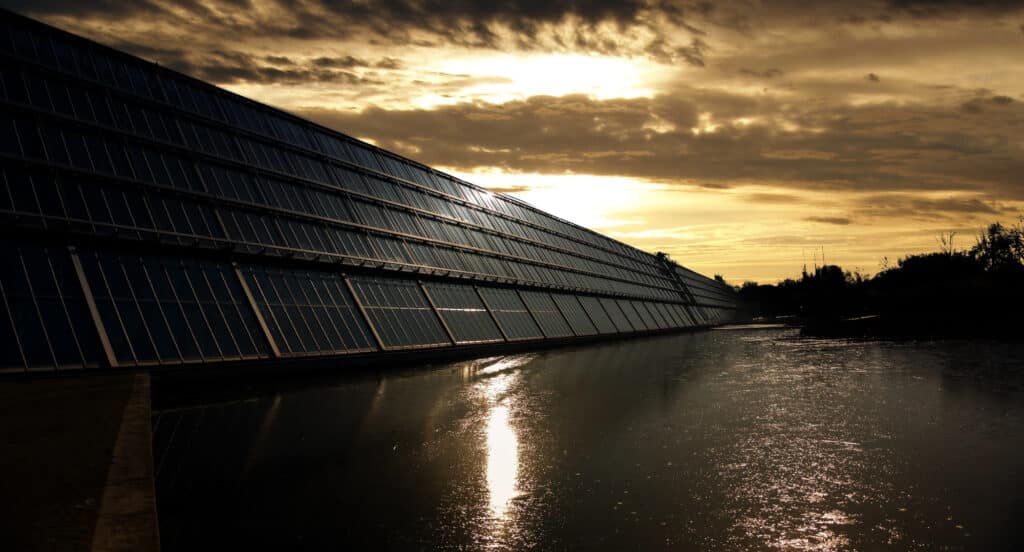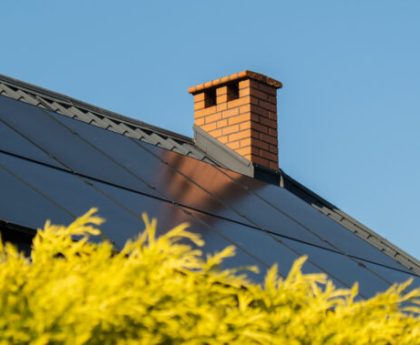What Is a Hybrid Solar System?
A hybrid solar system can switch between two operating modes: grid-tied and off-grid. This is achieved by combining two key components:
You can use only traditional solar power systems when connected to the grid. Solar panels cannot always provide a stable power supply for home appliances. If a cloud passes by, there will be an inevitable drop in power generation. The same concept applies to nighttime when no sunlight is available. In this case, you can cover any gaps in solar output using grid energy.
Hybrid solar systems use a battery system to provide energy even when your panels are disconnected from the grid. If the electricity output of your solar panels decreases due to cloudy conditions, a charged solar battery can sustain a stable voltage and power output. In other words, hybrid PV systems can interact with the local electricity grid but don’t depend on it.
How Does a Hybrid Solar System Work?
A hybrid solar power system uses a special type of inverter, called a hybrid inverter, capable of managing PV panels and batteries simultaneously. This type of inverter accomplishes several functions:
- Converts the electricity output from the solar panels or battery system from direct current (DC) electricity to the alternating current (AC) electricity needed to power your home.
- Manages your system’s solar battery charging cycle.
- Synchronizes with the local power grid voltage to operate in grid-tied mode.
You can use your hybrid system’s battery even when connected to the grid. For example, if your battery charges during the day, you can use that energy at night instead of paying for grid power.
There are two ways to add energy storage if you have a grid-tied solar system with a traditional inverter. You can upgrade to a hybrid inverter capable of handling batteries, or you can leave the existing inverter in place and install a separate battery inverter.
How Much Do Hybrid Solar Systems Cost?
A hybrid solar system costs between $20,000 to $40,000 on average, according to the Florida solar company PES Solar. However, costs may vary depending on your installer, equipment, number of solar batteries and location.
Generally, solar systems without battery storage cost $15,000 to $20,000. A battery can add around $10,000 or more to your total system cost — for example, the Tesla Powerwall costs $11,500 with installation. With a single battery, system costs may run closer to $26,500 to $31,500. However, you may need more than one battery depending on your energy usage, which will increase your costs.
You can lower the cost of your solar system by taking advantage of incentives, like the 30% federal solar tax credit and local rebates. Find out what state and local incentives are offered in your area using the dropdown below.
Benefits of Hybrid Solar Systems
The main advantage of a hybrid solar system is flexibility — you have the features of grid-tied and off-grid systems in a single installation. Other benefits include:
Increased Electricity Bill Savings
When using stand-alone solar panels, you can only use generated electricity during the day unless you have a battery or rely on grid power. On the other hand, a hybrid solar installation can operate as a 24/7 power supply, covering your energy consumption day and night. An installer can size your solar array to cover your daytime consumption and generate additional energy you can store in a battery for later use.
Most states have net metering programs that allow you to send excess power to the grid in exchange for billing credits. However, many net metering programs only give partial credit for excess energy, while a hybrid PV system saves the full value of each kilowatt-hour of electricity.
Backup Power During Blackouts
Since a hybrid solar system is equipped with energy storage, it can provide backup power during electricity outages. You cannot use a grid-tied solar system in the same way since PV modules alone cannot provide a stable voltage.
Even if you live in a place where power outages are not frequent, a hybrid solar system gives you energy independence. For example, if you pay a time-of-use (TOU) tariff with higher electricity prices during peak hours, you can go off-grid during peak rate times.
Qualifying for More Financial Incentives
Traditional solar systems only qualify for solar incentives, while energy storage systems are also eligible for energy storage incentives. You can also receive a higher federal solar tax credit if you install a hybrid solar system — you can claim 30% of solar costs plus 30% of battery costs against your federal tax burden.
In locations without a favorable net metering policy, a hybrid solar system can save you more money than a traditional solar installation. For example, California recently introduced the Net Energy Metering 3.0 (NEM 3.0) policy, which drastically reduces power bill credits for grid-tied solar systems. In this case, it makes more sense to store energy for later use instead of sending it to the grid.
Components of a Hybrid Solar System
A hybrid solar system uses many interacting components, including:
- Solar panels: Hybrid solar systems use the same PV panels as traditional installations.
- Hybrid inverter: This is a special type of inverter, capable of connecting to both solar panels and battery storage systems.
- Battery system: The battery in a hybrid solar system can provide backup power during blackouts. It also allows you to use solar energy at any time, even when your PV modules are not generating power. Your installer may recommend lithium batteries over lead-acid batteries due to their superior efficiency and longer service life.
- Energy management system: The energy management system controls the electricity flows between your solar panels, battery backup system, home appliances and local power grid. Energy management software is normally included with hybrid inverters.
High-quality residential solar panels can last for more than 25 years. Solar inverters and battery systems have a typical service life of 10 to 12 years, so you will eventually need a replacement over the lifespan of your system.
Integration with Energy Storage
Battery storage is optional for grid-connected solar systems, but necessary for off-grid operation. There are two main ways to integrate a battery bank with a solar panel system: you can use a hybrid inverter or install a separate battery inverter.
Using a Hybrid Inverter
A hybrid inverter can convert the electricity output of a solar array from DC power to AC power while managing the charging cycle of a home battery. This configuration is called a DC-coupled system since the solar panels and battery interact through the DC side of a hybrid inverter. The LG Chem RESU is an example of a DC-coupled battery.
Installing a Separate Battery Inverter
If you already own a solar power system and your existing inverter is not compatible with energy storage, you can simply add a solar battery with a dedicated inverter. This is called an AC-coupled system since there is no DC connection between the panels and the battery. The popular Tesla Powerwall is an AC-coupled battery.
The term “hybrid solar system” typically describes a solar array and battery in a DC-coupled configuration. The term is not commonly used for AC-coupled systems.
Grid Connectivity and Interaction
Going off-grid is possible when you combine your solar panels with an energy storage system. However, there are several benefits to staying connected to the grid:
- You can sell excess energy by participating in net metering programs.
- You can use the grid as backup during cloudy weather, at night or in other conditions when solar panels may not be able to generate enough electricity.
- Some solar incentives are only available for grid-connected systems.
The interconnection requirements for home solar systems vary depending on your location and the electric utility company. However, power companies demand a professional installation by a licensed contractor, which means DIY solar systems are not eligible for grid connection. Your solar installation must also comply with IEEE 1547 and UL 1741 standards.
The best solar companies are familiar with interconnection requirements across the U.S. and can ensure your solar project is installed and approved for use without hassle.
The Bottom Line
A hybrid solar system can cover the energy needs of your home during normal conditions, and it includes a backup battery you can use during power outages. The idea of going fully off-grid with solar energy can seem tempting, but a hybrid PV system offers a better return on investment for homeowners. You can achieve energy independence while participating in net metering and other solar incentives only available for grid-tied systems.
Generally, hybrid solar systems cost $20,000 to $40,000 on average. While costs may run higher than a traditional solar array without battery storage, you may be eligible for additional incentives. We recommend getting free quotes from at least three providers before deciding on the right solar system for your home.
This post was originally published on 3rd party site mentioned in the title of this site






